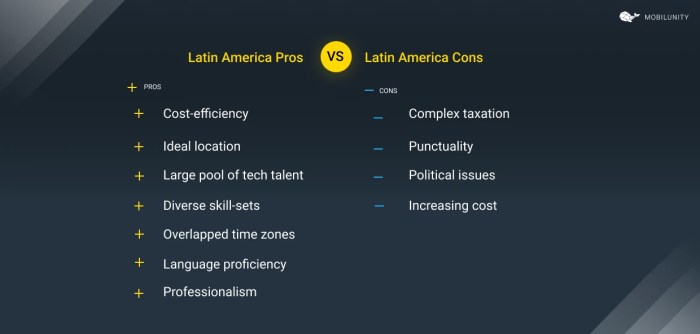Software development latin america – Latin America is experiencing a significant surge in its software development sector, transforming from a region primarily focused on outsourcing to a vibrant ecosystem of innovation and technological advancement. This growth is driven by a confluence of factors, including a burgeoning young and tech-savvy population, increasing investment in education and infrastructure, and a growing demand for digital solutions across various industries.
This article delves into the intricacies of Latin American software development, exploring its strengths, challenges, and future prospects.
The Rise of Latin American Tech Talent
One of the key drivers behind the region’s success is its abundant pool of skilled software developers. Latin American universities and coding bootcamps are producing a steady stream of talented professionals proficient in various programming languages and technologies. Countries like Brazil, Mexico, Argentina, and Colombia are particularly prominent in this regard, boasting a large number of developers with expertise in areas such as:

Source: mobilunity.com
- Web Development: Frontend and backend development using frameworks like React, Angular, Node.js, and others are widely prevalent.
- Mobile App Development: Native (iOS and Android) and cross-platform development using frameworks like React Native, Flutter, and Xamarin are in high demand.
- Data Science and Machine Learning: With the increasing importance of data-driven decision-making, expertise in Python, R, and related technologies is growing rapidly.
- Game Development: The region is seeing a rise in independent game studios and developers contributing to the global gaming industry.
- Cybersecurity: As digital threats increase, the demand for cybersecurity professionals is also on the rise.
Factors Contributing to Tech Talent Growth:, Software development latin america
- Growing Number of Universities and Coding Bootcamps: These institutions are providing quality education and training, equipping individuals with the necessary skills for the industry.
- Government Initiatives: Many Latin American governments are actively promoting STEM education and investing in digital infrastructure to foster technological growth.
- Remote Work Opportunities: The rise of remote work has opened up global opportunities for Latin American developers, allowing them to work for companies worldwide.
- Bilingual Proficiency: Many Latin American developers are bilingual (Spanish and English), making them highly sought after in international markets.
Challenges Faced by the Latin American Software Development Industry: Software Development Latin America
Despite the significant progress, the Latin American software development industry still faces several challenges:
- Digital Divide: Unequal access to technology and internet connectivity across the region hinders the growth of the tech sector in certain areas.
- Brain Drain: Talented developers sometimes seek opportunities in more developed countries, leading to a loss of skilled workforce within the region.
- Infrastructure Limitations: In some areas, inadequate infrastructure, including reliable internet access and power supply, can pose obstacles.
- Bureaucracy and Regulations: Complex bureaucratic processes and regulations can sometimes hinder business growth and investment.
- Lack of Venture Capital: Compared to other regions, access to venture capital and funding for startups remains a challenge in some parts of Latin America.
The Future of Software Development in Latin America
The future of software development in Latin America looks bright. Continued investment in education, infrastructure, and innovation will further propel the region’s growth. The increasing adoption of technology across various sectors, including finance, healthcare, and agriculture, will create even more opportunities for software developers. Furthermore, the growing presence of multinational technology companies in the region is fostering collaboration and knowledge transfer.
Emerging Trends:
- Fintech Innovation: Latin America is witnessing a boom in fintech startups, driving demand for developers with expertise in financial technology.
- E-commerce Growth: The expansion of e-commerce is creating opportunities for developers specializing in e-commerce platforms and related technologies.
- Focus on Sustainability: There’s a growing interest in developing sustainable technology solutions, creating opportunities for developers focused on green tech.
- Artificial Intelligence (AI) and Machine Learning (ML): AI and ML are transforming various industries, leading to increased demand for developers with expertise in these areas.
Key Countries and Cities in Latin American Software Development
Several countries and cities stand out as major hubs for software development in Latin America:
- Brazil (São Paulo, Rio de Janeiro): Brazil boasts the largest software development market in Latin America, with a significant concentration of talent in its major cities.
- Mexico (Mexico City, Guadalajara): Mexico is a rapidly growing tech hub, attracting significant investment and fostering innovation.
- Argentina (Buenos Aires): Argentina has a strong tradition in software development, with a highly skilled workforce and a thriving startup ecosystem.
- Colombia (Medellín, Bogotá): Colombia is emerging as a prominent player in the Latin American tech scene, with a focus on outsourcing and nearshore development.
- Chile (Santiago): Chile is known for its strong focus on innovation and technology, attracting both local and international investment.
Frequently Asked Questions (FAQ)
- Q: What programming languages are most in demand in Latin America?
A: Popular languages include Java, Python, JavaScript, C#, PHP, and Swift, among others. The specific demand varies depending on the area of specialization. - Q: Is it easy to find work as a software developer in Latin America?
A: The job market for software developers is competitive but generally favorable, particularly for those with strong skills and experience. Opportunities are abundant in major cities. - Q: What are the average salaries for software developers in Latin America?
A: Salaries vary considerably depending on experience, skills, location, and company. However, they are generally competitive compared to other regions, especially considering the cost of living. - Q: What are the best resources for learning software development in Latin America?
A: Numerous online courses, coding bootcamps, and universities offer excellent resources for learning software development. Many resources are available in Spanish and Portuguese. - Q: What are the biggest challenges for startups in the Latin American software development industry?
A: Challenges include securing funding, navigating regulatory hurdles, and competing with established players. However, the potential for growth is significant.
References
- Statista (For market data and statistics)
- LinkedIn (For job market insights and professional profiles)
- Crunchbase (For information on startups and funding)
Call to Action
Are you a software developer looking for exciting opportunities? Or are you a company seeking talented developers in Latin America? Explore the vibrant tech scene and connect with the growing community of developers and businesses in this dynamic region. Contact us today to learn more about the possibilities!
Common Queries
What are the most common programming languages used in Latin America?
Spanish-speaking countries frequently utilize Java, JavaScript, Python, and PHP. However, the specific languages vary based on the project and company.

Source: waverleysoftware.com
What are the major tech hubs in Latin America?
Major tech hubs include Mexico City (Mexico), São Paulo (Brazil), Buenos Aires (Argentina), Bogotá (Colombia), and Santiago (Chile), but vibrant scenes are also emerging in other cities.
What are the salary expectations for software developers in Latin America?

Source: mobilunity.com
Salaries vary widely based on experience, location, and specific skills. Generally, they are lower than in North America or Europe, but are competitive within the region.
What are the cultural considerations for working with Latin American developers?
Strong communication and cultural sensitivity are crucial. Understanding time zone differences and communication styles is essential for effective collaboration.
